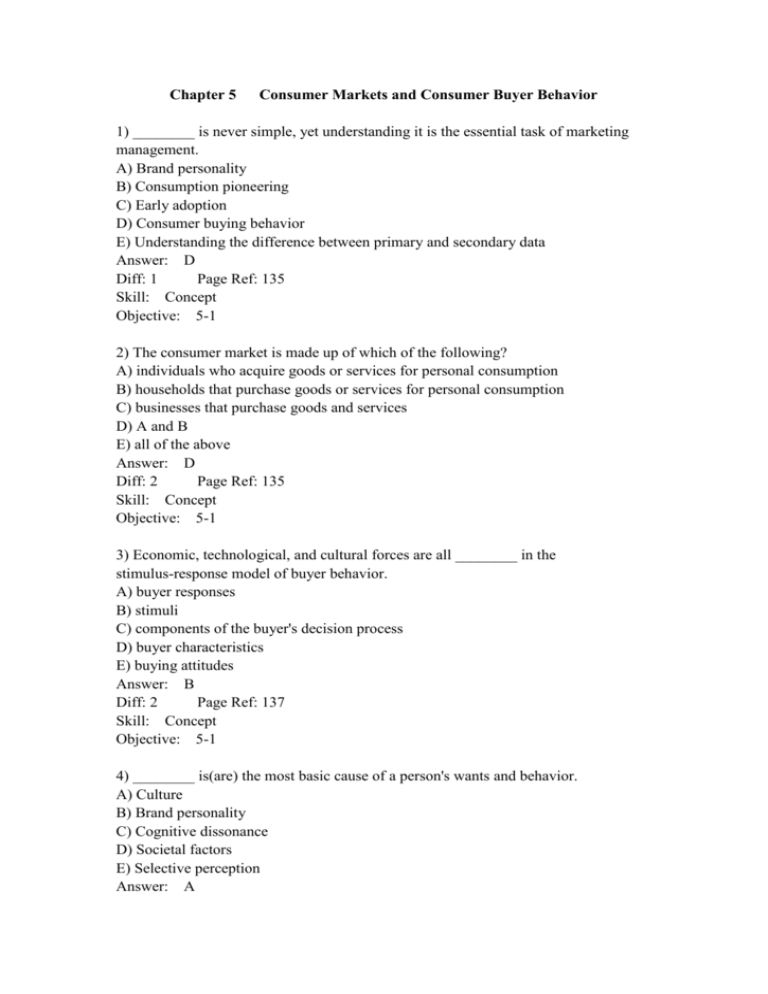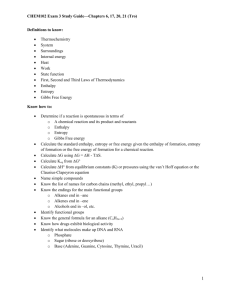Chapter 5 Consumer Markets and Consumer Buyer Behavior
advertisement

Chapter 5 Consumer Markets and Consumer Buyer Behavior 1) ________ is never simple, yet understanding it is the essential task of marketing management. A) Brand personality B) Consumption pioneering C) Early adoption D) Consumer buying behavior E) Understanding the difference between primary and secondary data Answer: D Diff: 1 Page Ref: 135 Skill: Concept Objective: 5-1 2) The consumer market is made up of which of the following? A) individuals who acquire goods or services for personal consumption B) households that purchase goods or services for personal consumption C) businesses that purchase goods and services D) A and B E) all of the above Answer: D Diff: 2 Page Ref: 135 Skill: Concept Objective: 5-1 3) Economic, technological, and cultural forces are all ________ in the stimulus-response model of buyer behavior. A) buyer responses B) stimuli C) components of the buyer's decision process D) buyer characteristics E) buying attitudes Answer: B Diff: 2 Page Ref: 137 Skill: Concept Objective: 5-1 4) ________ is(are) the most basic cause of a person's wants and behavior. A) Culture B) Brand personality C) Cognitive dissonance D) Societal factors E) Selective perception Answer: A Diff: 1 Page Ref: 137 Skill: Concept Objective: 5-2 5) Marketers are always trying to spot ________ in order to discover new products that might be wanted. A) lifestyles B) cultural shifts C) groups D) dissonance E) attitudes Answer: B Diff: 3 Page Ref: 137 Skill: Concept Objective: 5-2 6) Each culture contains smaller ________, or groups of people with shared value systems based on common life experiences and situations. A) alternative evaluations B) cognitive dissonances C) subcultures D) motives E) attitudes Answer: C Diff: 1 Page Ref: 137 AACSB: Multicultural and Diversity Skill: Concept Objective: 5-2 7) Which of the following best explains why a rush of marketers now participate in established online social networks? A) Social networking has been proven to be more effective than traditional marketing. B) Social networks allow companies to have greater control over brand-related content than other media do. C) Members of social networking sites are unlikely to tune out personalized advertising messages. D) Companies have found their own social networks to be unsuccessful. E) Consumers are more likely to view to peer-to-peer communication as credible. Answer: E Diff: 3 Page Ref: 144 AACSB: Communication Skill: Concept Objective: 5-2 8) The ________ is the most important consumer buying organization in society; the roles and influences of different members have been researched extensively. A) family B) social class C) membership group D) subculture E) reference group Answer: A Diff: 2 Page Ref: 145 Skill: Concept Objective: 5-2 9) When consumers are highly involved with the purchase of an expensive product and they perceive significant differences among brands, they most likely will undertake ________. A) habitual buying behavior B) complex buying behavior C) reflective buying behavior D) habitual buying behavior E) variety-seeking buying behavior Answer: B Diff: 2 Page Ref: 152 Skill: Concept Objective: 5-3 10) Which of the following typically occurs with habitual buying behavior? A) There is high consumer involvement. B) There is strong brand loyalty. C) Consumers search extensively for information. D) Ad repetition creates brand conviction. E) none of the above Answer: E Diff: 2 Page Ref: 152 Skill: Concept Objective: 5-3 11) When customers have a low involvement in a purchase but perceive significant brand differences, they will most likely engage in ________. A) complex buying behavior B) dissonance-reducing buying behavior C) habitual buying behavior D) variety-seeking buying behavior E) brand conviction buying behavior Answer: D Diff: 2 Page Ref: 153 Skill: Concept Objective: 5-3 12) Almost all major purchases result in ________, or discomfort caused by postpurchase conflict. A) need recognition B) cognitive dissonance C) purchase decisions D) legitimization E) dissatisfaction Answer: B Diff: 1 Page Ref: 155 Skill: Concept Objective: 5-3 13) Consumers learn about new products for the first time and make the decision to buy them during the ________. A) need recognition stage B) adoption process C) evaluation process D) trial process E) quality assessment Answer: B Diff: 1 Page Ref: 158 Skill: Concept Objective: 5-4 14) Which of the following is NOT one of the stages that customers go through in the process of learning about and making decisions about a new product or service? A) awareness B) interest C) evaluation D) culture E) trial Answer: D Diff: 2 Page Ref: 158 Skill: Concept Objective: 5-4 15) Bob's job description had been changed. The rationale for the changes made no sense to Bob when they were explained. Bob continued to perform most of his job duties as usual. He has engaged in ________. A) selective distortion B) selective attitude C) selective interpretation D) selective attention E) perceptual defense Answer: D Diff: 2 Page Ref: 150 AACSB: Reflective Thinking Skill: Application Objective: 5-2 16) Stephanie and Jamal attended a sales seminar. Both left the seminar with differing opinions about what was important to implement in their jobs. Both used the information in different ways, according to what each already believed was important. They have engaged in ________. A) selective distortion B) selective attitude C) selective retention D) selective attention E) perceptual defense Answer: A Diff: 2 Page Ref: 150 AACSB: Reflective Thinking Skill: Application Objective: 5-3 17) Leona purchased two bottles of wine from vineyards in Australia. When asked her opinion of the wine, she said the burgundy wine tasted like alcoholic grape juice, but the Chablis had a crisp taste that she really enjoyed. These statements were made during the ________ stage of the purchase decision. A) information search B) situational analysis C) alternative evaluation D) purchase decision E) postpurchase behavior Answer: E Diff: 1 Page Ref: 155 AACSB: Reflective Thinking Skill: Application Objective: 5-3 18) Cameron loves to know about and purchase the most up-to-date technological gadgets. Among his friends, he is almost always the first to own the newest electronic product. Often the products that Cameron buys become adopted by large groups of consumers, but occasionally Cameron will purchase a product that is adopted by only a small portion of the population. To which of the following adopter groups does Cameron belong? A) innovator B) early adopter C) early majority D) late majority E) laggards Answer: A Diff: 2 Page Ref: 158 AACSB: Reflective Thinking Skill: Application Objective: 5-4 19) The starting point of understanding how consumers respond to various marketing efforts is called the marketing stimulus model of buyer behavior. Answer: FALSE Diff: 2 Page Ref: 136 Skill: Concept Objective: 5-1 20) Subcultures are society's relatively permanent and ordered divisions whose members share similar values, interests, and behaviors. Answer: FALSE Diff: 1 Page Ref: 137 AACSB: Multicultural and Diversity Skill: Concept Objective: 5-2 21) Younger consumers are better off financially than mature consumers. They are the ideal market for travel, restaurants, high-tech home entertainment products, and convenient services. Answer: FALSE Diff: 2 Page Ref: 140 AACSB: Multicultural and Diversity Skill: Concept Objective: 5-2 22) Social class is based on shared value systems and common life experiences and situations. Answer: FALSE Diff: 2 Page Ref: 140 Skill: Concept Objective: 5-2 23) Because people are able to move between social classes, these classes are relatively impermanent and disordered divisions whose members share dissimilar values, interests, and behaviors. Answer: FALSE Diff: 2 Page Ref: 140 AACSB: Analytic Skills Skill: Application Objective: 5-2 24) Online social networks represent an important new form of buzz for marketers. Answer: TRUE Diff: 2 Page Ref: 144 AACSB: Use of IT Skill: Concept Objective: 5-2 25) Children exert little influence on family buying decisions, particularly in areas such as entertainment and food. Answer: FALSE Diff: 2 Page Ref: 146 Skill: Concept Objective: 5-2 26) Personality is a person's pattern of living as expressed in his or her psychographics. Answer: FALSE Diff: 1 Page Ref: 148 Skill: Concept Objective: 5-2 27) After purchasing a product, the consumer will be satisfied or dissatisfied and will engage in post-purchase behavior. Answer: TRUE Diff: 1 Page Ref: 155 Skill: Concept Objective: 5-3 28) Most unhappy customers explain their reasons for dissatisfaction to the company who sold the product. Answer: FALSE Diff: 2 Page Ref: 157 Skill: Concept Objective: 5-3 29) When a consumer learns about a new product for the first time and makes a decision to try it, the consumer is engaged in the alternative evaluation process. Answer: FALSE Diff: 2 Page Ref: 154 Skill: Concept Objective: 5-4 30) People differ greatly in their readiness to try new products. In each product area, there are "consumption pioneers." They are also called laggards. Answer: FALSE Diff: 2 Page Ref: 158 Skill: Concept Objective: 5-4






